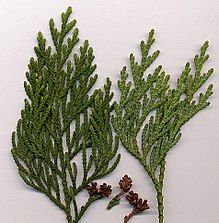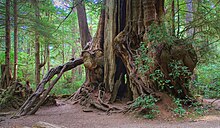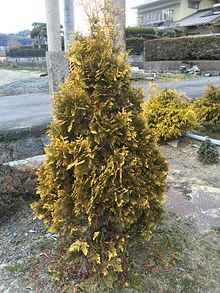Thuja
| Thuja | |
|---|---|

| |
| Thuja standishiifoliage and cones | |
| Scientific classification | |
| Kingdom: | Plantae |
| Clade: | Tracheophytes |
| Clade: | Gymnospermae |
| Division: | Pinophyta |
| Class: | Pinopsida |
| Order: | Cupressales |
| Family: | Cupressaceae |
| Subfamily: | Cupressoideae |
| Genus: | Thuja L. |
| Type species | |
| Thuja occidentalis L.
| |
Thuja(/ˈθjuːdʒə/THEW-jə)[1]is a genus ofconiferoustreeorshrubin theCupressaceae(cypress family). There are five species in the genus, two native toNorth Americaand three native to easternAsia.[2][3][4][5]The genus ismonophyleticand sister toThujopsis.Members are commonly known asarborvitaes(from theLatinterm for 'tree of life'),thujasorcedars.[6]
Description[edit]

Thujaareevergreentreesgrowing from 10 to 200 feet (3 to 61 metres) tall, with stringy-textured reddish-brownbark.The shoots are flat, with side shoots only in a single plane. The leaves are scale-like and 1 to 10 mm (0.039 to 0.394 in) long, except young seedlings in their first year, which have needle-like leaves. The scale leaves are arranged in alternating decussate pairs in four rows along the twigs. The male cones are small, inconspicuous, and are located at the tips of the twigs. The femaleconesstart out similarly inconspicuous, but grow to about 1 to 2 cm (0.39 to 0.79 in) long at maturity when 6–8 months old; they have 6-12 overlapping, thin, leathery scales, each scale bearing 1–2 smallseedswith a pair of narrow lateral wings.[3]
The five species in the genusThujaare small to large evergreen trees with flattenedbranchlets.The leaves are arranged in flattened fan shaped groupings with resin-glands, and oppositely grouped in 4 ranks. The mature leaves are different from younger leaves, with those on larger branchlets having sharp, erect, free apices. The leaves on flattened lateral branchlets are crowded into appressed groups and scale-like and the lateral pairs are keeled. With the exception ofT. plicata,the lateral leaves are shorter than the facial leaves (Liet al.2005). The solitary flowers are produced terminally. Pollen cones with 2-6 pairs of 2-4 pollen sacked sporophylls. Seed cones are ellipsoid, typically 9 to 14 mm (0.35 to 0.55 in) long, and mature and open the first year. The thin woody cone scales number from 4-6 pairs and are persistent and overlapping, with an oblong shape, they are also basifixed. The central 2-3 pairs of cone scales are fertile. The seed cones produce 1 to 3 seeds per scale, the seeds are lenticular in shape and equally 2 winged. Seedlings produce 2 cotyledons.[7][8]




AhybridbetweenT. standishiandT. plicatahas been named as thecultivarThuja'Green Giant'.
Another very distinct and only distantly related species, formerly treated asThuja orientalis,is now treated in a genus of its own, asPlatycladus orientalis.The closest relatives ofThujaareThujopsis dolabrata,distinct in its thicker foliage and stouter cones, andTetraclinis articulata(Ancient Greekθυίαorθύα,formerly classed in the genus and after whichThujais named), distinct in its quadrangular foliage (not flattened) and cones with four thick, woody scales.
The genusThuja,like many other forms of conifers, is represented by ancestral forms inCretaceousrocks of northern Europe, and with the advance of time is found to migrate from northerly to more southerly regions, until during thePlioceneperiod, when it disappeared from Europe.Thujais also known in theMiocenebeds ofthe Dakotas.[9]
Taxonomy[edit]
Phylogeny[edit]
| Stull et al. 2021[10][11] |
|---|
Species[edit]
The five extant species are:[2][12][13]
| Image | Scientific name | Common Name | Distribution |
|---|---|---|---|
 |
Thuja koraiensisNakai | Korean thuja | Jilin,Korea |
 |
Thuja occidentalisL. | eastern arborvitae, northern whitecedar | E Canada (ManitobatoNova Scotia), E United States (primarilyNortheast,Great Lakes,Appalachians) |
 |
Thuja plicataDonn ex D.Don | western redcedar | fromAlaskatoMendocino CountyinCalifornia |
 |
Thuja standishii(Gordon) Carrière | Japanese thuja | Honshu,Shikoku |
| Thuja sutchuenensis(Gordon) Carrière | Sichuan thuja | Sichuan,ChongqingChina almost extinct in the wild |
Species formerly placed inThujainclude:[2]
- Austrocedrus chilensis(D.Don) Pic.Serm. & Bizzarri(asT. chilensisD.Don)
- Callitris rhomboideaR.Br. ex Rich.(asT. australisPoir.)
- Cupressus nootkatensisD.Don(asT. excelsaBong.)
- Dacrycarpus imbricatus(Blume) de Laub(asT. javanicaBurm.f.)
- Glyptostrobus pensilis(Staunton ex D.Don) K.Koch(asT. pensilisStaunton ex D.Don)
- Libocedrus plumosa(D.Don) Sarg.(asT. donianaHook.)
- Platycladus orientalis(L.) Franco(asT. orientalisL.)
- Tamarix aphylla(L.) H.Karst.(asT. aphyllaL.)
- Tetraclinis articulata(Vahl) Mast.(asT. articulataVahl)
- Thujopsis dolabrata(Thunb. ex L.f.) Siebold & Zucc.(asT. dolabrataThunb. ex L.f.)
- Widdringtonia nodiflora(L.) Powrie(asT. cupressoidesL.)
and many more
The extant speciesThuja sutchuenensiswas believed to be extinct until 1999, when a small population was discovered in southeast China.[14]
Ecology[edit]
Thujaspecies are used as food plants by thelarvaeof someLepidopteraspecies includingautumnal moth,theengrailedandjuniper pug.The foliage is also readily eaten bydeer,and where deer population density is high, can adversely affect the growth of young trees and the establishment of seedlings.[15]
Distribution[edit]
The genusThujahas current populations in both North America and East Asia.T. plicatahas wide distribution in the Pacific Northwest from Northern California to Alaska, reaching East into Idaho and central British Columbia.T. occidentalishas populations in the Northeastern United States, reaching north into Ontario and Quebec, with some distribution as far south as Tennessee.[16]
T. standishiihas populations in mountainous regions of Honshu and Shikoku islands in Japan, with no recorded population in the north of the country.T. koraiensisis native to both North and South Korea and has a small population in the Northern Chinese province of Jilin.[17]The newly rediscovered speciesT. sutchuenensishas extremely limited distribution in the mountains of Chengkou county in southeastern China.
Evolution and paleobiogeography[edit]
Current research suggests thatThujaoriginated in the Americas and migrated to East Asia via theBering land bridgein theMiocene.Fossil records show that Thuja was significantly more widely distributed during the lateCretaceousandearly Tertiarythan we see today.[18]The oldest knownThujafossil is ofT. polaris(an extinct species) from the Paleocene of Ellesmere Island in present-day Nunavut, Canada.[17]
Other hypotheses ofThujaorigin involved an East Asian origin, with the genus migrating twice; once east into North-western America and then west to the North-eastern America, but since no reliable fossil records ofThujaexist in either Western Asia or Europe, the possibility can be eliminated.[17]
Systematics[edit]
Thuja is a monophyletic genus that sits within the order Pinales in the Cupressaceae.Thujais in the Cupressoid clade and is sister to the genusThujopsis.The sister relationship betweenThujaandThujopsisis supported with 100% bootstrap support and 1.0 posterior probability.[19]
Within the genus the taxonomy is in flux, but most recent research based on molecular analysis of plastomes in the genusThujashowed evidence for a new grouping, with two sister clades:T. standishiiandT. koraiensistogether andT. occidentalisandT. sutchuenensistogether, withT. plicatasister toT. occidentailsandT. sutchuenensis.[19]This newest grouping is hypothesized to be the result of reticulate evolution and hybridization within the genus.
Uses of thuja[edit]
They are widely grown asornamental trees,and extensively used forhedges.A number of cultivars are grown and used in landscapes.[20][21]Homeowners will sometimes plant them as privacy trees. The cultivar 'Green Giant' is popular as a very vigorous hedging plant, growing up to 80 cm/year when young.[22]
Thewoodis light, soft and aromatic. It can be easily split and resists decay. The wood has been used for many applications from making chests that repel moths to shingles.Thujapoles are also often used to make fence posts and rails. The wood ofThuja plicatais commonly used forguitarsound boards.[23]Its combination of light weight and resistance to decay has also led toT. plicatabeing widely used for the construction of bee hives.[24]
T. plicatais an important tree to the First Nations people of the Pacific Northwest and is sometimes called "Canoe Tree" because of its use as a material for Native American canoes.[citation needed]
Oil ofThujacontains theterpenethujonewhich has been studied for itsGABAreceptor antagonizing effects, with potentially lethal properties.[25]Cedarwood oil and cedar leaf oil, which are derived fromThuja occidentalis,have different properties and uses.[26]
The natives of Canada used the scaled leaves ofThuja occidentalisto make a tea that has been shown to contain 50 mg of vitamin C per 100 grams; this helped prevent and treatscurvy.[27]
In the 19th century,Thujawas commonly used as an externally applied tincture or ointment for the treatment ofwarts,ringwormandthrush,[28]and a local injection of the tincture was used for treatingvenereal warts.[29]
A 2017 trial showed that its extract effectively killed both gram-positive and gram-negative bacteria.[30]
As with many Cupressaceae,Thujacan induce allergic reactions, including skin, eye and breathing problems.[citation needed]
References[edit]
- ^Sunset Western Garden Book,1995:606–607
"Thuja".Oxford English Dictionary(Online ed.).Oxford University Press.(Subscription orparticipating institution membershiprequired.) - ^abc"Thuja".World Checklist of Selected Plant Families(WCSP).Royal Botanic Gardens, Kew.
- ^abFarjon, A. (2005).Monograph of Cupressaceae and Sciadopitys.Kew: Royal Botanic Gardens.ISBN978-1-84246-068-9.
- ^Earle, Christopher J., ed. (2018)."Thuja".The Gymnosperm Database.
- ^Fu, Liguo; Yu, Yong-fu; Adams, Robert P.; Farjon, Aljos."Thuja".Flora of China.Vol. 4 – via eFloras.org,Missouri Botanical Garden,St. Louis, MO &Harvard University Herbaria,Cambridge, MA.
- ^USDA, NRCS(n.d.)."Thuja".The PLANTS Database (plants.usda.gov).Greensboro, North Carolina: National Plant Data Team.Retrieved9 December2015.
- ^Chambers, Kenton L. (1993)."Thuja".In Flora of North America Editorial Committee (ed.).Flora of North America North of Mexico (FNA).Vol. 2. New York and Oxford: Oxford University Press – via eFloras.org,Missouri Botanical Garden,St. Louis, MO &Harvard University Herbaria,Cambridge, MA.
- ^Gleason, Henry A.New Britton and Brown Illustrated Flora of Eastern North America and Adjacent Canada.Vol. 1: The Pteridophya, Gymnospermae and Monocotyledoneae. Hafner Press. pp. 58–67.
{{cite encyclopedia}}:Missing or empty|title=(help) - ^Gilman, D. C.;Peck, H. T.; Colby, F. M., eds. (1905)..New International Encyclopedia(1st ed.). New York: Dodd, Mead.
- ^Stull, Gregory W.; Qu, Xiao-Jian; Parins-Fukuchi, Caroline; Yang, Ying-Ying; Yang, Jun-Bo; Yang, Zhi-Yun; Hu, Yi; Ma, Hong; Soltis, Pamela S.; Soltis, Douglas E.; Li, De-Zhu; Smith, Stephen A.; Yi, Ting-Shuang; et al. (2021)."Gene duplications and phylogenomic conflict underlie major pulses of phenotypic evolution in gymnosperms".Nature Plants.7(8): 1015–1025.bioRxiv10.1101/2021.03.13.435279.doi:10.1038/s41477-021-00964-4.PMID34282286.S2CID232282918.
- ^Stull, Gregory W.; et al. (2021)."main.dated.supermatrix.tree.T9.tre".Figshare.doi:10.6084/m9.figshare.14547354.v1.
{{cite journal}}:Cite journal requires|journal=(help) - ^"GRIN Species Records ofThuja".Germplasm Resources Information Network.United States Department of Agriculture.Retrieved2013-01-22.
- ^"Thuja".County-level distribution maps from the North American Plant Atlas (NAPA).Biota of North America Program (BONAP). 2014.
- ^Qiaoping, Xiang; Fajon, A.; Zhenyu, Li; Likuo, Fu; Zhengyu, Liu (2002-07-01)."Thuja sutchuenensis: a rediscovered species of the Cupressaceae".Botanical Journal of the Linnean Society.139(3): 305–310.doi:10.1046/j.1095-8339.2002.00055.x.ISSN0024-4074.
- ^Stein, W. I. (1997)."Ten-year survival and growth of planted Douglas-fir and western redcedar after seven site-preparation treatments".Western Journal of Applied Forestry.12(3): 74–80.doi:10.1093/wjaf/12.3.74.
- ^Cowley, Jill; Zheng-yi, Wu; Raven, Peter H. (1997). "Flora of China Volume 15, Myrsinaceae through Loganiaceae".Kew Bulletin.52(3): 765.doi:10.2307/4110318.ISSN0075-5974.JSTOR4110318.
- ^abcCui, Yi-Ming; Sun, Bin; Wang, Hai-Feng; Ferguson, David Kay; Wang, Yu-Fei; Li, Cheng-Sen; Yang, Jian; Ma, Qing-Wen (2015-09-22)."Exploring the Formation of a Disjunctive Pattern between Eastern Asia and North America Based on Fossil Evidence fromThuja(Cupressaceae) ".PLOS ONE.10(9): e0138544.Bibcode:2015PLoSO..1038544C.doi:10.1371/journal.pone.0138544.ISSN1932-6203.PMC4579098.PMID26393513.
- ^Peng, Dan; Wang, Xiao-Quan (June 2008). "Reticulate evolution in Thuja inferred from multiple gene sequences: Implications for the study of biogeographical disjunction between eastern Asia and North America".Molecular Phylogenetics and Evolution.47(3): 1190–1202.doi:10.1016/j.ympev.2008.02.001.ISSN1055-7903.PMID18346917.
- ^abAdelalu, Kole F.; Zhang, Xu; Qu, Xiaojian; Landis, Jacob B.; Sun, Yanxia; Meng, Aiping; Sun, Hang; Wang, Hengchang (2019-08-30)."Plastome phylogenomic and biogeographic study on Thuja (Cupressaceae)".doi:10.21203/rs.2.13750/v1.
{{cite journal}}:Cite journal requires|journal=(help) - ^Brand, Mark H. (2001)."Thuja plicata".UConn Plant Database.University of Connecticut. Archived fromthe originalon 2007-10-29.
- ^Brand, Mark H. (2001)."Thuja occidentalis".UConn Plant Database.University of Connecticut. Archived fromthe originalon 2007-10-21.
- ^"U.S. National Arboretum: Gardens: FAQs: 'Green Giant' Arborvitae".Archived fromthe originalon 2013-01-27.Retrieved2008-01-23.
- ^Bucur, Voichita (1995). "Acoustics of wood". Boca Raton: CRC Press.
{{cite web}}:Missing or empty|url=(help) - ^Owano, Nacy."Flow Hive 2 sees sweet success in offering new features for honey on tap".Tech Xplore.Retrieved15 October2022.
- ^Höld KM, Sirisoma NS, Ikeda T, Narahashi T, Casida JE (2000)."Alpha-thujone (the active component of absinthe): gamma-aminobutyric acid type A receptor modulation and metabolic detoxification".Proc. Natl. Acad. Sci. U.S.A.97(8): 3826–31.Bibcode:2000PNAS...97.3826H.doi:10.1073/pnas.070042397.PMC18101.PMID10725394.
- ^"Cedarwood Oil Vs Cedar Leaf Oil".Cedar Leaf Canada.Retrieved16 June2015.
- ^Johnston, William F. (1990)."Thuja occidentalis".In Burns, Russell M.; Honkala, Barbara H. (eds.).Conifers.Silvics of North America.Vol. 1.Washington, D.C.:United States Forest Service(USFS),United States Department of Agriculture(USDA) – via Southern Research Station.
- ^Hoffmann, David (2003).Medical Herbalism: Principles and Practices.Healing Arts Press. p. 588.ISBN978-0-89281-749-8.
- ^Grieve, M. (1931).A Modern Herbal.London: Jonathan Cape. p. 177.
- ^Sah, Shiv Nandan; Regmi, Sunil; Tamang, Man Kumar (2017-06-29)."Antibacterial Effects of Thuja Leaves Extract".International Journal of Applied Sciences and Biotechnology.5(2): 256–260.doi:10.3126/ijasbt.v5i2.17617.ISSN2091-2609.
External links[edit]
- .Encyclopedia Americana.1920.
